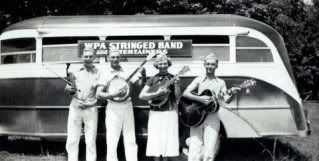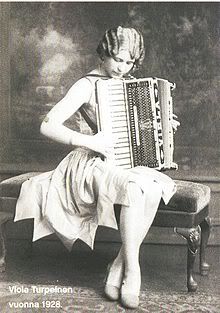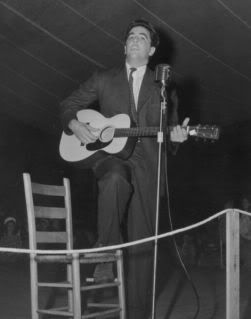
The WPA Stringed Band of Flat Rock performed
in Delta County during the Great Depression of the 1930s.
By STEVE SEYMOUR
While the Upper Peninsula suffered in the Great Depression just like the rest of the country, home grown music thrived in northern Michigan during that time, even if the economy didn't.
Consider that U. P. native Viola Turpeinen was a major recording star, that musicologist Alan Lomax recorded nearly 1,000 ethnic folk songs during a trip to the area and that the federal government launched a program in Delta County which trained hundreds of youths to play musical instruments.
Still, the whole country was singing the blues after the stock market crash of 1929 brought on the decade-long Great Depression.
"Brother, Can You Spare a Dime" became a No. 1 hit for Bing Crosby and Rudee Vallee on separate occasions.
Bing Crosby
Written by E. Y. Harburg (lyrics) and Jay Gorney (music), the song became an anthem of the Great Depression. The song is said to represent a World War I veteran's reflection on his life as a jobless person after fighting for his country just a few years before.
Duke Ellington's "It Don't Mean a Thing (If It Ain't Got That Swing)" was another popular song of the era, which saw unemployment hit 25 percent and poverty and despair reach new heights.
Not as well-known nationally as Crosby, Vallee or Ellington, the U. P.'s Viola Turpeinen was a superstar in the Finnish-American community, concentrated in the area surrounding western Lake Superior.
Born in Champion in 1909, Turpeinen grew up in Marquette County where her immigrant father worked in an iron mine.
Known as the "Finnish-American Princess," she left northern Michigan for New York City at age 18.
There, she parlayed her vocal and accordion skills into a recording career, becoming the first female accordion player to have her work preserved on wax.
She recorded dozens of 78 rpm discs for the Victor and Columbia labels in the late 1920s and 30s, mainly polkas, waltzes, hambos and schottisches.
Her songs carry such names as "Woods of Finland Polka," "Heina Hika" and "Let's Go Polka." She recorded those songs and others with an ensemble including her husband William Syralia.
Viola Turpeinen
Turpeinen toured extensively, playing many dances and concerts, becoming the biggest star in Finnish-American music. Her fame extended to Finland, as well.
She was active for a decade beginning in the late 1920s and from just after World War II until 1954.
I own three record albums of Turpeinen material released on the Colonial label by the Standard Phono Corp. Two of the albums feature Finnish scenes on the cover while the third carries a portrait of Turpeinen and her accordion. The company released at least half a dozen albums by the Finnish-American star.
Turpeinen, 49, died of cancer in 1958 at her home in Florida, leaving behind a legacy of Finnish music.
Preserving the U. P.'s diverse ethnic music was the goal of Alan Lomax, who visited northern Michigan on a recording expedition in 1938, paid for by the federal government.
During his early career, he traversed the south recording such blues notables as Leadbelly and Jellyroll Morton.
In a report to the Library of Congress, Lomax noted "The Upper Peninsula proved to be the most fertile source of material. After six week of recording a mass of lumberjack, Finnish and French folk-songs, I felt that there was material enough in the region for years of work.
"Near Newberry, Munising, Greenland and Ontonagon, it was comparatively easy to find lumberjack singers. Everywhere through the Copper Country and south of it, Finnish singers generously furnished me with more material than I had time to record. In Champion and Baraga, I found French ballad singers who still enjoyed ballad fests that lasted all night long."
Recordings were also made in St. Ignace, Champion, Marinesco, Amasa, Calumet, Fulton, Charles, Round Lake, Hancock, Allouez, Laurium and Ironwood.
Alan Lomax
Lomax spent much of the fall recording Finnish musicians in the western U. P., returning to Washington, D. C. in late 1938.
While Lomax sought to preserve the folk songs of various ethnic groups, the federal Works Progress Administration sought to bring music to the people by teaching youngsters to play musical instruments.
In Delta County, Joseph Bussineau was hired by the federal government to launch a music program in Flat Rock. Bussineau taught violin, mandolin and banjo to young students who had no previous musical training.
The local program was started in early 1936 when large numbers of eager young people began to congregate at Bussineau's residence in Flat Rock. Soon, his basement became a studio where the aspiring musicians were taught in groups every night of the week, beginning at 7 p. m.
After six months of instruction, the students began to make free public appearances all around the area, including a performance at the Bark River community building on June 16, 1936.
The public, desiring to forget about the economic hardships of the time, responded with enthusiasm.
Early on, the band included 86 pieces, then 150, and finally, over 200 youngsters participated. The group, known as the Junior Music Club, made dozens of appearances to entertain the weary public.
In addition, Bussineau noted the program had another benefit. "It is one way to deal with the child delinquency problem. Give the children something to do in which they are interested and you will have no trouble."
Also billed as the WPA Stringed Band of Flat Rock, the group performed for the 50th time at the Flat Rock town hall on Dec. 15, 1937.
Bussineau even requested and received airtime on radio station WBEO in Marquette for his group. The 15-minute broadcast took place at 10 a. m. on Sunday, June 4, 1939. One of their final performances took place at the second annual U. P. Townsend Rally and Picnic, held Aug. 4, 1940 at the fairgrounds in Escanaba.
By 1940, the country was emerging from the Great Depression and World War II was on the horizon.
Nationally, jazz and big band music from the likes of Benny Goodman, Glenn Miller and Tommy Dorsey rose in popularity during the financially-difficult 1930s. Folk singer Woody Guthrie also gained national recognition during this period.
In the geographically-remote Upper Peninsula, Viola Turpeinen was a star, but to a lesser extent so were the scores of ethnic musicians recorded by Alan Lomax and the hundreds of youngsters who took up string instruments under the tutelage of Joseph Bussineau.
###


 I've enjoyed rock music and writing since I was a teenager in the 60s. I feel lucky to have been around when rock's greatest stars created their most enduring hits. At the same time I found I enjoyed writing, as well. I worked on my high school newspaper and magazine, was editor of several college publications and earned a bachelor's degree from Central Michigan University in 1973. I worked for the daily newspaper in my hometown after graduating, becoming managing editor after a few years. By the 1980s, I moved into public relations. In 1985, my wife Sue and I opened a retail music store, The Record Rack, which we still own. Rock 'n' roll has been integral to me and for the last 2O years I've been earning my living from it even though I don't have a musical bone in my body. In recent years, I've also I edited a small local magazine and launched a micro FM radio station. Now, I'm finally combining my love of writing and rock 'n' roll. I can't sing a note, but I know what I like. I'll tell you all about it when you read on. I hope you have as much enjoyment reading these installments as I've had writing them.
I've enjoyed rock music and writing since I was a teenager in the 60s. I feel lucky to have been around when rock's greatest stars created their most enduring hits. At the same time I found I enjoyed writing, as well. I worked on my high school newspaper and magazine, was editor of several college publications and earned a bachelor's degree from Central Michigan University in 1973. I worked for the daily newspaper in my hometown after graduating, becoming managing editor after a few years. By the 1980s, I moved into public relations. In 1985, my wife Sue and I opened a retail music store, The Record Rack, which we still own. Rock 'n' roll has been integral to me and for the last 2O years I've been earning my living from it even though I don't have a musical bone in my body. In recent years, I've also I edited a small local magazine and launched a micro FM radio station. Now, I'm finally combining my love of writing and rock 'n' roll. I can't sing a note, but I know what I like. I'll tell you all about it when you read on. I hope you have as much enjoyment reading these installments as I've had writing them.


3 comments:
A most excellent column! It is quite timely, given the Great Depression that so many of us have been experiencing for some time, if the media has been glibly glossing over it for some time. And the tie-ins to the U.P. and its insightful glimpses behind the curtain of the music industry are exciting and fascinating, as always. THANK YOU!!!!
Joseph Bussineau was my Grandfather. I have very fond memories of him.
I grew up across the street from Joseph Bussineau when he lived in Wells. My mother told me about taking music lessons from him as a teenager. Because of those lessons, she made sure each of her kids had music lessons on some instument. It worked too - two music teachers out of five kids:)
Post a Comment